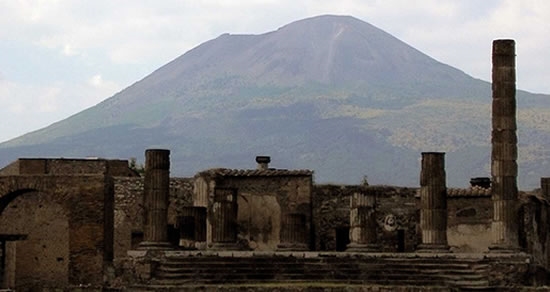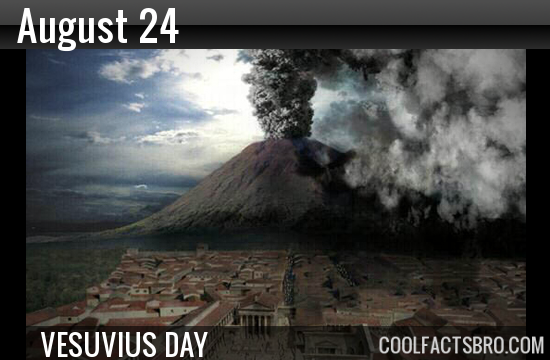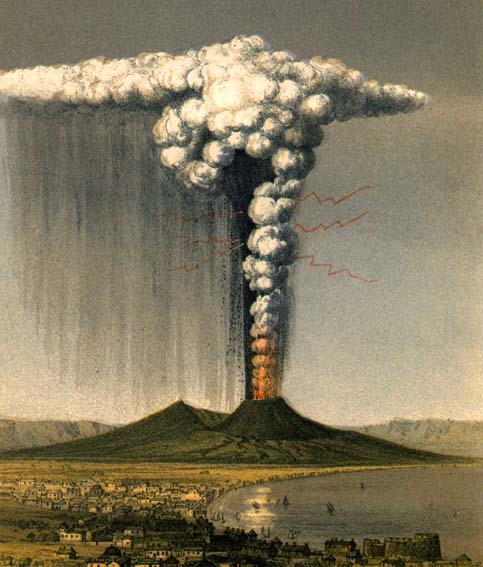Vesuvius Day 2024 is on Saturday, August 24, 2024: What are the volcanic hazards of Mount. Vesuvius?
Saturday, August 24, 2024 is Vesuvius Day 2024. August 24th is Vesuvius Day August 24th is Vesuvius Day
As an Amazon Associate I earn from qualifying purchases.

Vesuvius Day remember the historic eruption of Mount Vesuvius On August 24, 79 A.D, which destroyed the town of Pompeii and surrounding areas in a single of history’s biggest recorded volcanic explosions.

my favorite volcano!
Today two million people live in the immediate vicinity of Mount Vesuvius. This mountain has erupted more than 50 times since the eruption in 79 A.D., when it buried Pompeii and its sister city, Herculaneum. After Pompeii was buried and lost to history, the volcano continued to erupt every 100 years until about 1037 A.D., when it entered a 600-year period of quiescence. In 1631, the volcano killed an additional 4000 unsuspecting inhabitants. It was during the restoration after this eruption that workers discovered the ruins of Pompeii, buried and forgotten for nearly 1600 years. It would take another 300 years for the excavations to reveal the story of Pompeii and Herculaneum. For excellent coverage of Pompeii, Vesuvius, and the continuing narrative of tragic human involvement with nature, readers may want to locate a copy of Planet Earth: Volcano by Time-Life Books.
it IS an active strato-volcano east of Naples, Italy. It also is conspicuous in the beautiful landscape presented by that bay, when seen from the sea, with Naples in the foreground.
as far as in preparredness
The emergency plan for an eruption therefore assumes that the worst case will be an eruption of similar size and type to the 1631 VEI 4[40] one. In this scenario the slopes of the mountain, extending out to about 7 kilometres (4.3 mi) from the vent, may be exposed to pyroclastic flows sweeping down them, whilst much of the surrounding area could suffer from tephra falls. Because of prevailing winds, towns to the south and east of the volcano are most at risk from this, and it is assumed that tephra accumulation exceeding 100 kg/m² – at which point people are at risk from collapsing roofs – may extend out as far as Avellino to the east or Salerno to the south east. Towards Naples, to the north west, this tephra fall hazard is assumed to extend barely past the slopes of the volcano.[39] The specific areas actually affected by the ash cloud will depend upon the particular circumstances surrounding the eruption.[41]
The area around the volcano is now densely populated.The plan assumes between two weeks and 20 days [42][43] notice of an eruption and foresees the emergency evacuation of 600,000 people, almost entirely comprising all those living in the zona rossa ("red zone"), i.e. at greatest risk from pyroclastic flows. The evacuation, by trains, ferries, cars, and buses is planned to take about seven days, and the evacuees will mostly be sent to other parts of the country rather than to safe areas in the local Campania region, and may have to stay away for several months. However the dilemma that would face those implementing the plan is when to start this massive evacuation, since if it is left too late then many people could be killed, whilst if it is started too early then the precursors of the eruption may turn out to have been a false alarm. In 1984, 40,000 people were evacuated from the Campi Flegrei area, another volcanic complex near Naples, but no eruption occurred.[43]
Ongoing efforts are being made to reduce the population living in the red zone, by demolishing illegally constructed buildings, establishing a national park around the upper flanks of the volcano to prevent the erection of further buildings[43] and by offering financial incentives to people for moving away. The underlying goal is to reduce the time needed to evacuate the area, over the next 20 or 30 years, to two or three days.[44]
The volcano is closely monitored by the Osservatorio Vesuvio in Naples with extensive networks of seismic and gravimetric stations, a combination of a GPS-based geodetic array and satellite-based synthetic aperture radar[45] to measure ground movement, and by local surveys and chemical analyses of gases emitted from fumaroles. All of this is intended to track magma rising underneath the volcano. So far, no magma has been detected within 10 km of the surface, and so the volcano was, in 2001, at worst only in the very early stages of preparing for an eruption.[39] This status has apparently not changed much to date

Mount Vesuvius!!!!!?
Mount Vesuvius is an active volcano, originated during the late Pleistocene Epoch. It is famous for its catastrophic eruption in 79 A.C. when the town of Pompei, Herculaneum, Oplonti and Stabiae were completely destroyed and buried in less than two days time. Pompei was buried under 10 feet (3 m) of tephra, while Herculaneum was buried under 75 feet (23 m) of ash deposited by a pyroclastic flow. More than 3300 people died during the eruption. During its history, Mount Vesuvius has alternated periods of intense eruptive activity to cycles of quiescence. Since the eruption of 79 A.C. it erupted violently twice: the first time in 472 A.C. and the second time in 1631 when almost 3500 people were killed.
During the last 3 centuries the activity of the volcano has been characterised by eruptions of medium scale but of spectacular effects which has made the Vesuvius one of the aims of travellers, scientists and artists from all over the world.
After the last eruption in 1944, the volcano has entered a cycle of quiescence and no one can predict how long it is going to last. In the last decades the area around the Vesuvius has been jolted by small earthquakes and its activity is proved by the presence of two major fumarole in the volcanic area.
The eruptive history of this volcano proves that the Vesuvius is still alive and is to be considered one of the most dangerous volcanoes.
The Vesuvian Observatory, inaugurated in 1845 by Ferdinando II, king of the Reign of Two Sicilies, is the first seismic observatory to be establish in the world. For more than 150 years it has assured a constant and detailed observation of the vesuvianae eruptions and its precursors. Now the observatory keeps under control the activities of the vulcanoes present in Campania and it is capable of catching any signs of a renewed activity.

Pompeii, Herculaneum, Vesuvius, and Sorrento by Circumvesuviana?
Both Ercolano (Herculaneum) and Pompeii could be seen in a day en route to Sorrento on the Circumvesuviana if you restrict your time at the two sites. It would be fairly easy to spend a full day in Pompeii alone though. Both stops are on the circumvesuviana line that runs between Naples and Sorrento so you can do this as a continuous trip. Just get off at the Ercolano - Scavi stop for Herculaneum; it's only about a 17inute trip from the Circumvesuviana stop at the Naples Garibaldi station (Napoli Centrale station). When you're done there, get back on the train going toward Sorrento to get to the Pompei - Scavi stop (it's another 19 minutes on the train. From Pompei - Scavi to Sorrento at the end of the day takes another 31 minutes on the train.
There's a trip planner for the Circumvesuviana trains here:
You won't have time to go up on Vesuvius and do the two ruins in a single day and if you try to combine the two ruins, you'll have to spend less time in each. Vesuvius is very visible though and there are some good views from both Pompeii and Sorrento.















